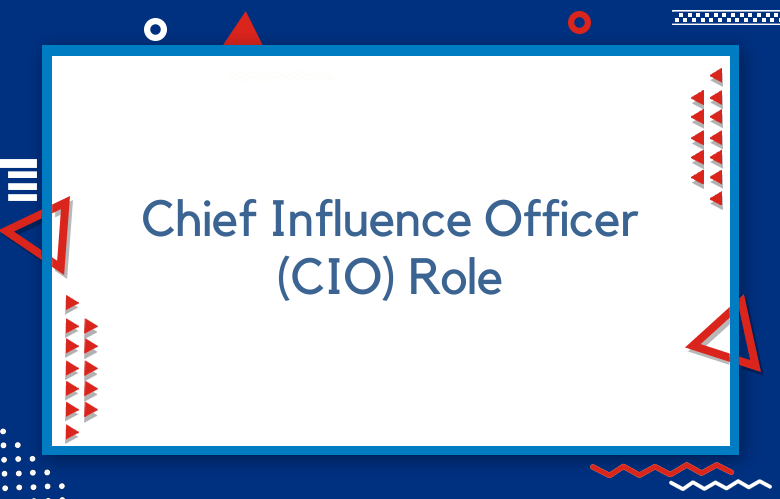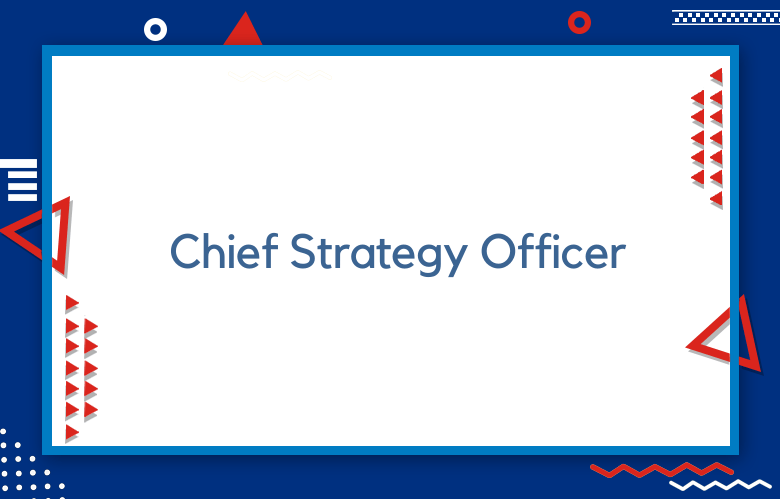Chief Influence Officer (CIO) Role and Responsibilities

The Chief Influence Officer (CIO) is a unique and rapidly growing role within organizations seeking to leverage the power of influence marketing to drive business growth.
As organizations recognize the importance of building authentic customer relationships, the CIO plays a critical role in shaping the organization’s influence marketing strategy and building a network of influencers, brand ambassadors, and loyal customers.
Chief Influence Officer (CIO) Role and Responsibilities
The “Chief Influence Officer” (CIO) concept is not a standard title or role within traditional corporate structures. However, if we consider the term “Chief Influence Officer” broadly, it could be interpreted as a strategic role focused on shaping and guiding the organization’s internal and external influence.
This role would blend leadership, communication, strategy, and stakeholder engagement to maximize the organization’s impact on its industry, customers, and workforce.
The CIO’s responsibilities include:
Developing an Influencer Marketing Strategy
The CIO works with senior leadership to develop an influencer marketing strategy that aligns with the organization’s overall business goals. This strategy includes identifying influencers, developing relationships with them, and leveraging their influence to promote the organization’s products or services.
Recruiting and Managing Influencers
The CIO recruits and manages a network of influencers aligned with the organization’s brand values and target audience. This includes negotiating contracts, creating content plans, and monitoring influencer performance and engagement.
Developing Brand Ambassadors
The CIO works to identify and develop brand ambassadors who are passionate customers who advocate for the organization’s products or services. These brand ambassadors can help to spread positive word-of-mouth and increase brand loyalty.
The CIO’s Corner: Unleashing Influence in the Digital Age
In the digital age, influence has become more critical than ever before. With the rise of social media, the power of influence has been democratized, allowing individuals and organizations to shape opinions, drive conversations, and build strong relationships with their target audience.
The Chief Influence Officer (CIO) plays a crucial role in harnessing the power of influence in the digital age. By leveraging digital platforms and strategies, the CIO can build a strong and engaged following, amplify the organization’s message, and drive positive change.
Here are some ways in which the CIO can unleash influence in the digital age:
Leveraging Social Media
Social media platforms like Twitter, Instagram, and LinkedIn allow the CIO to connect with key stakeholders, share the organization’s story, and build a community of brand advocates. By engaging with followers, sharing valuable content, and participating in conversations, the CIO can amplify the organization’s message and increase its influence.
Creating Compelling Content
In the digital age, content is king. By creating compelling and shareable content, the CIO can attract and engage key stakeholders, build the organization’s reputation, and establish it as a thought leader in its industry. This content can take many forms, including blog posts, videos, infographics, and social media updates.
Building Digital Partnerships
By building partnerships with other influencers, organizations, and media outlets, the CIO can extend the organization’s reach and amplify its message. These partnerships can take many forms, including co-branded content, guest blogging, and social media collaborations.
Fostering a Digital Community
By fostering a digital community of key stakeholders, the CIO can build a substantial, engaged following that is invested in the organization’s success. This community can be built through social media, online forums, and other digital platforms and can provide valuable insights, feedback, and support for the organization’s initiatives.
Leveraging Data and Analytics
Using data and analytics to measure the impact of influence efforts, the CIO can optimize the organization’s strategy and ensure it achieves its goals. This can include measuring metrics like social media engagement, website traffic, and conversion rates, as well as more qualitative measures like customer satisfaction and brand perception.
Influence as a Superpower: The CIO’s Secret Weapon
In the digital age, influence has become a superpower that can make or break an organization’s success. With the proliferation of social media, online communities, and digital communication channels, the ability to influence others has become more critical than ever before. The Chief Influence Officer (CIO) is the key player who wields this superpower, shaping the organization’s influence strategy and leveraging the power of influence to drive positive change.
The CIO’s secret weapon is their ability to identify, understand, and harness the power of influence. By leveraging influence, the CIO can help organizations achieve their strategic goals, build strong relationships with key stakeholders, and create a more engaged and innovative workplace.
Beyond Technology: The CIO’s Evolving Role in Influence
The Chief Information Officer (CIO) role has significantly transformed in recent years, evolving well beyond its traditional confines of overseeing an organization’s IT infrastructure and technology projects.
Today, the CIO’s role encompasses a broader sphere of influence, extending into strategic decision-making, innovation, and organizational change. This evolution reflects the increasing recognition of technology as a central driver of business strategy and competitive advantage.
In the past, CIOs were often viewed primarily as technical leaders responsible for maintaining operational IT systems and ensuring the reliability of technical services. However, as technology has become more intertwined with every aspect of business operations, the CIO’s role has expanded to include shaping business strategy, driving innovation, and facilitating digital transformation.
This shift has elevated the CIO from a back-office function to a key executive leadership team member, directly influencing the organization’s direction and success.
The CIO’s Guide to Mastering Influence in the Corporate World
The corporate world is a complex and competitive environment where influence is crucial in driving success. The ability to influence others is a critical skill for anyone seeking to advance their career and positively impact their organization.
Mastering influence is particularly important for chief influence officers (CIOs), as they are responsible for shaping the organization’s influence strategy and leveraging the power of influence to drive positive change.
Here are some strategies for CIOs to master influence in the corporate world:
Develop Strong Communication Skills
Effective communication is the foundation of influence. CIOs should develop strong verbal and written communication and active listening skills to build relationships, gain trust, and effectively convey their message.
Build Relationships
Influence is built on relationships. CIOs should develop solid relationships with key stakeholders, including employees, customers, partners, and thought leaders. By cultivating these relationships, CIOs can leverage their influence to drive positive change and achieve the organization’s strategic goals.
Identify Key Influencers
CIOs should identify key influencers within the organization and its ecosystem and develop strategies to leverage their influence to drive positive change. This may involve building relationships with these individuals, aligning their goals with the organization’s goals, and providing them with the support and resources they need to succeed.
Create a Compelling Vision
A compelling vision is essential for influencing others. CIOs should create a clear and inspiring vision that aligns with the organization’s strategic goals and communicates the value and impact of influence. This vision should be communicated consistently across the organization and reinforced through ongoing communication and engagement.
Practice Empathy and Active Listening
CIOs should practice empathy and active listening, seeking to understand the perspectives and needs of key stakeholders. By demonstrating empathy and active listening, CIOs can build trust, strengthen relationships, and increase their influence.
Leverage Data and Analytics
Data and analytics can provide valuable insights into the impact of influence efforts. CIOs should leverage data and analytics to measure the effectiveness of their influence strategy, optimize their approach, and demonstrate the value of influence to the organization’s leadership.
By mastering these strategies, CIOs can effectively influence others, drive positive change, and achieve the organization’s strategic goals. Influence is a powerful tool in the corporate world, and CIOs who can master it will be well-positioned to impact their organization and career significantly.
The Art of Persuasion: How CIOs are Influencing Change
Chief Influence Officers (CIOs) are masters of persuasion, leveraging their skills to drive positive change within their organizations. By effectively persuading key stakeholders, CIOs can align their influence efforts with the organization’s strategic goals and objectives, build support for their initiatives, and accelerate change.
Effective persuasion involves a combination of art and science, and CIOs must master both to achieve their goals.
Influence in the Innovation Age: A CIO’s Imperative
In the Innovation Age, where rapid technological advancements and disruptive innovations are the norm, the Chief Information Officer (CIO) role has expanded significantly. In this era, the CIO’s imperative is not only to manage and oversee the organization’s IT infrastructure but also to wield influence across various aspects of the business to foster innovation, drive digital transformation, and ensure the organization remains competitive and relevant.
Conclusion:
The Chief Influence Officer (CIO) is vital in modern organizations seeking to build strong relationships with key stakeholders, drive positive change, and achieve their strategic goals. By leveraging the power of influence, the CIO can help organizations create a more engaged and innovative workplace, build a solid and distinctive brand identity, and drive business success.
As organizations increasingly recognize the importance of influence in building strong and lasting relationships with their customers, employees, and other stakeholders, the role of the CIO is likely to become even more crucial in the future. By championing influence across all aspects, the CIO can help organizations create a more engaged and innovative workplace, build a solid and distinctive brand identity, and drive business success.
The CIO’s responsibilities encompass a wide range of activities, from building relationships with key stakeholders to fostering a culture of influence within the organization. By effectively fulfilling these responsibilities, the CIO can help organizations create a more engaged and innovative workplace, build a solid and distinctive brand identity, and drive business success.



